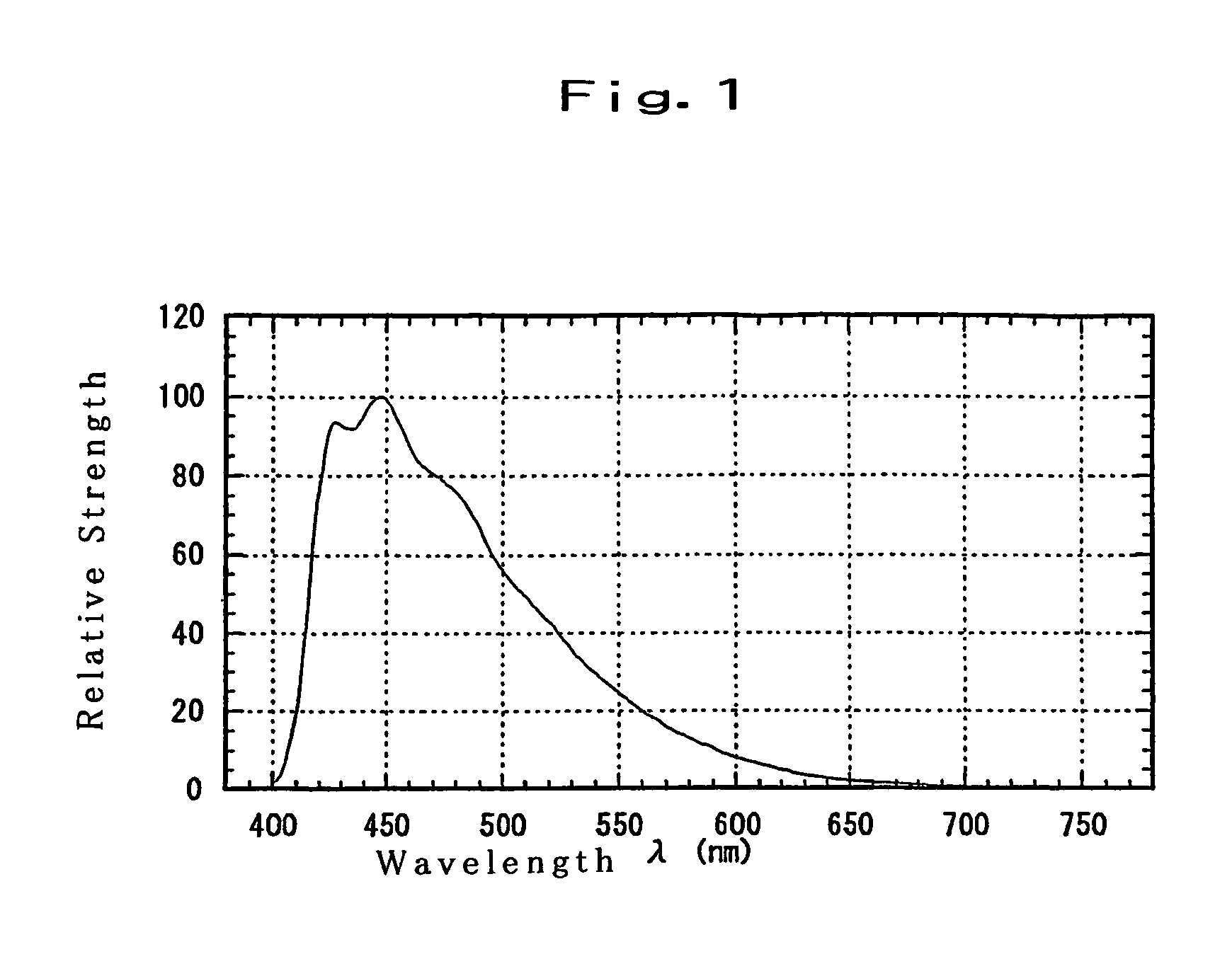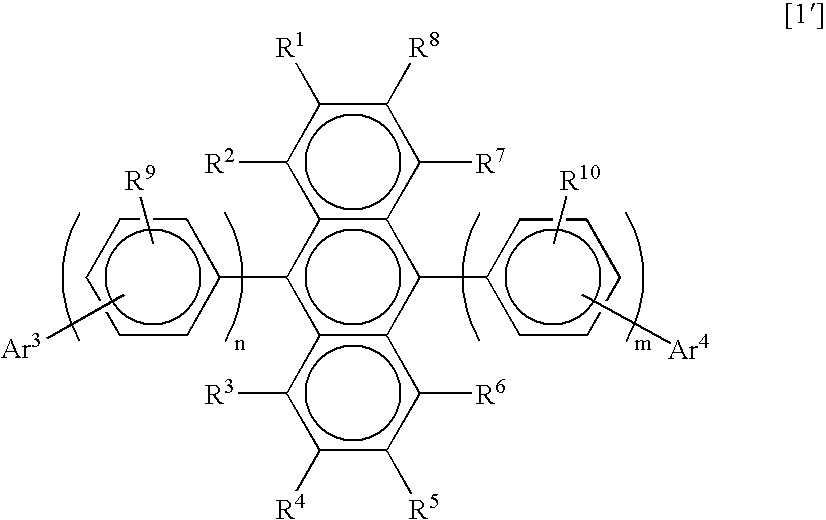Substituted diphenylanthracene compounds for organic electroluminescence devices
a technology of diphenylanthracene and organic electroluminescence, which is applied in the direction of discharge tube luminescnet screen, other domestic articles, organic semiconductor devices, etc., can solve the problems of insufficient light emission efficiency, heat resistance and life, and the inability to use organic el devices for practical applications, etc., to achieve excellent light emission and heat resistance efficiency, excellent color purity
- Summary
- Abstract
- Description
- Claims
- Application Information
AI Technical Summary
Benefits of technology
Problems solved by technology
Method used
Image
Examples
synthesis example 1
Compound 14
(1) Synthesis of 2,2′-dibromobiphenyl
[0076]Under an atmosphere of argon, 1,2-bromobenzene (25 g, 0.11 mole) was dissolved into anhydrous THF (240 ml) and the resultant solution was cooled at −67° C. in a dry ice / methanol bath. To the cooled solution, a hexane solution of n-butyllithium (1.50 mole / liter, 35 ml, 53 mmole, 0.5 eq) was slowly added dropwise over 5 minutes. The resultant mixture was stirred at −67° C. for 1 hour and then at the room temperature for 3 hours. To the obtained reaction mixture, a saturated aqueous solution of ammonium chloride (100 ml) was added. The formed organic layer was separated, washed with a saturated aqueous solution of sodium chloride (50 ml) and dried over anhydrous magnesium sulfate. Then, the solvent was removed by distillation and a brown liquid (about 19 g) was obtained. The obtained liquid was purified by the column chromatography (silica gel / hexane) and white needle crystals (9.5 g, 57%) were obtained.
[0077]1H-NMR (CDCl3, TMS) δ: ...
synthesis example 2
Compound 15
(1) Synthesis of 1-(2-bromophenyl)naphthalene
[0084]Under an atmosphere of argon, 2-bromoiodobenzene (7.0 g, 25 mmole), naphthaleneboronic acid (4.0 g, 23 mmole) and tetrakis(triphenylphosphine)palladium(0) (0.5 g, 0.43 mmole, 1.7% Pd) were dissolved into toluene (50 ml). To the obtained solution, an aqueous solution of sodium carbonate (7.3 g, 69 mmole, 3 eq / 35 ml) was added. The resultant solution was heated under refluxing for 10 hours and left standing for one night. The formed organic layer was separated, washed with a saturated aqueous solution of sodium chloride (50 ml) and dried with anhydrous magnesium sulfate. Then, the solvent was removed by distillation and a yellow oil was obtained. The obtained oil was purified by the column chromatography (silica gel / hexane, hexane+3% dichloromethane and hexane+10% dichloromethane, successively) and white needle crystals (5.4 g, 83%) were obtained.
[0085]1H-NMR (CDCl3, TMS) δ: 7.3 to 7.8 (9H, m), 7.90 (2H, dd, J=8 Hz, 2 Hz)
(2...
synthesis example 3
Compound 17
(1) Synthesis of 9-phenanthreneboronic acid
[0090]Under an atmosphere of argon, 9-bromophenanthrene (15 g, 58 mmole) was dissolved into anhydrous ether (150 ml) and the resultant solution was cooled at −35° C. in a dry ice / methanol bath. To the cooled solution, a hexane solution of n-butyllithium (1.50 mole / liter, 43 ml, 65 mmole) was added dropwise and the resultant mixture was stirred at −20° C. for 1 hour. After the reaction mixture was cooled at −67° C., a solution (30 ml) of triisopropoxyborane (37 ml, 0.16 mole, 2.8 eq) in anhydrous ether was added the resultant mixture was stirred at −65° C. for 1 hour and at the room temperature for 2 hours and left standing for one night. To the obtained reaction mixture, a 10% hydrochloric acid (150 ml) was added. After the resultant mixture was stirred at the room temperature for 1 hour, the formed organic layer was separated, washed with a saturated aqueous solution of sodium chloride (50 ml) and dried with anhydrous magnesium ...
PUM
| Property | Measurement | Unit |
|---|---|---|
| peak wavelength | aaaaa | aaaaa |
| work function | aaaaa | aaaaa |
| transmittance | aaaaa | aaaaa |
Abstract
Description
Claims
Application Information
 Login to View More
Login to View More - R&D
- Intellectual Property
- Life Sciences
- Materials
- Tech Scout
- Unparalleled Data Quality
- Higher Quality Content
- 60% Fewer Hallucinations
Browse by: Latest US Patents, China's latest patents, Technical Efficacy Thesaurus, Application Domain, Technology Topic, Popular Technical Reports.
© 2025 PatSnap. All rights reserved.Legal|Privacy policy|Modern Slavery Act Transparency Statement|Sitemap|About US| Contact US: help@patsnap.com



